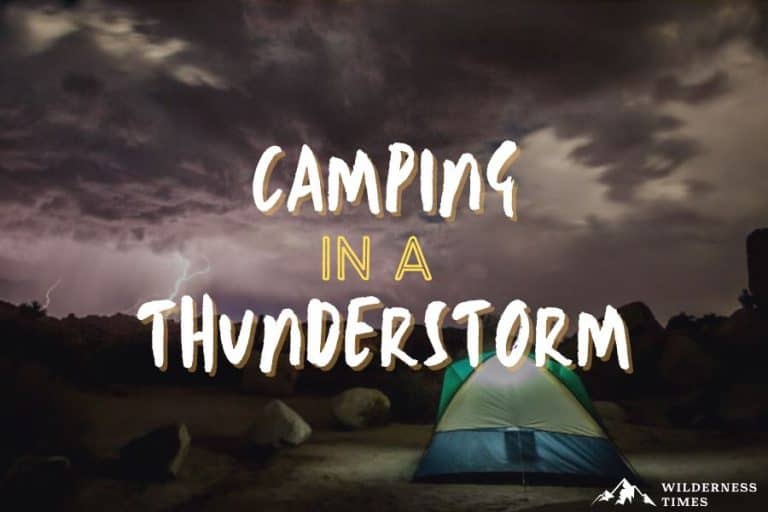The weather is about to turn for the worse unexpectedly?
There’s no need to panic. Don’t let a bit of bad weather destroy your camping trip.
With adequate knowledge and preparation, there’s no reason why you should change your camping plans altogether.
In this article, we’ll talk about what to do and what to avoid during camping in a thunderstorm.
Let’s get straight to the point.
Things to Keep in Mind While Camping in a Thunderstorm
First things first, there are a few things to keep in mind when you see a thunderstorm coming.
Avoid Exposure
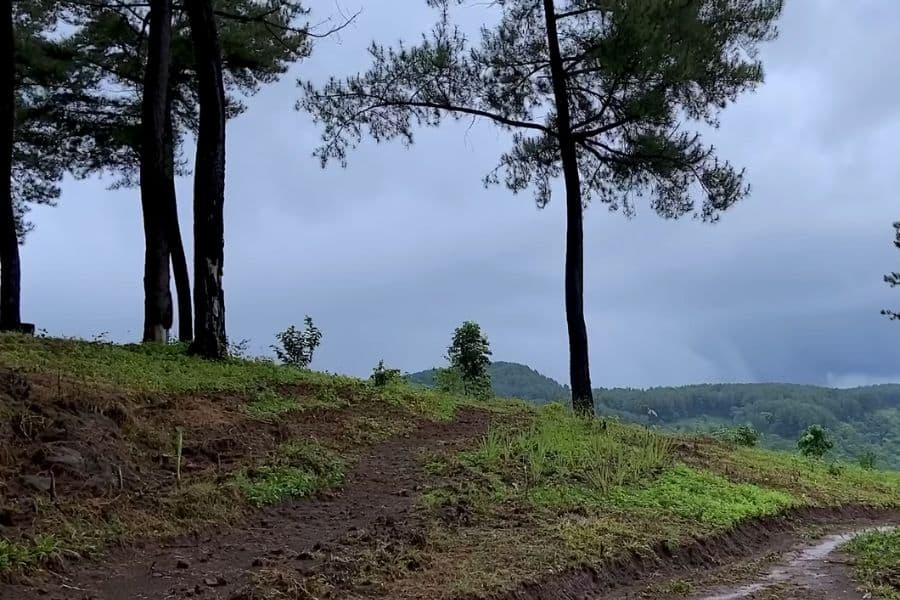
Depending on where you are located, thunderstorms can get quite dangerous.
Tornado seasons peak months of May and June, and can be extremely dangerous in the midwest and parts of the east coast.
In Mexico and the Southwest, there is an annual climate phenomenon called the North American Monsoon.
Monsoon season peaks from July to September, delivering heavy rains, wind, and lightning.
And lastly, the Atlantic Hurricane season will last from June all the way until November.
With that in mind, bad weather is not something to mess around with. If possible, you should try to avoid exposure if possible.
Be aware of weather patterns at all time, and do not be afraid to scrap a trip due to pending weather. It is simply not worth the risk.
Tents Provide No Protection, And Is Not Your Friend in a Thunderstorm
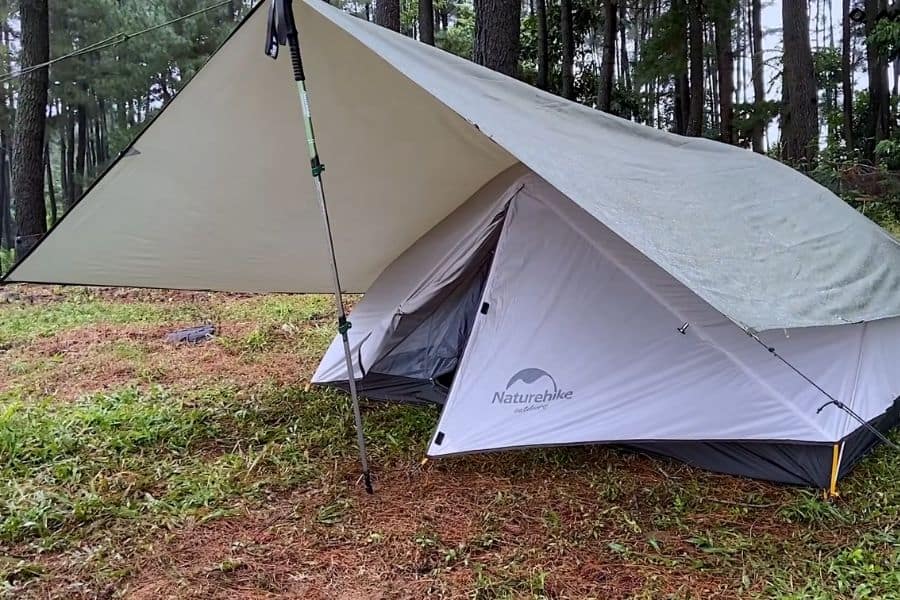
Now, I know that your tent is your shelter, but this is where that doesn’t actually apply.
When it comes to lighting, a tent does nothing to keep you safe.
In fact, it might actually be even more dangerous to stay inside, if it features metal poles which are great conductors.
If there are other shelter options nearby, consider hiding there until the storm passes by.
A solid building (like a campsite bathroom) will be your best option, but if there aren’t any, you can sit in your vehicle instead.
If you don’t have any other alternative – which is often the case when you’re out in the wilderness – the inside of your tent should be drier than the outside.
If it doesn’t have metal poles, you can hide from the rain inside. But as far as real protection from thunderstorms, don’t expect much.
Lightning Hurts You Without Being Struck

Did you know that the chance of being struck by lightning is 1 in 15,300? That’s pretty rare.
But you don’t actually have to be struck by lightning to get burned by electricity.
If the lighting strikes your tent, the energy can discharge into the soil and through the tent poles or frame.
Now, let’s say you were sitting inside, close to the pole when that occurs.
What would happen is that the lighting can jump to your body through a side flash.
Now, you don’t need me to tell you how dangerous it can be for electricity to run through your body.
Plus, the electric energy discharged into the soil can accumulate directly underneath the tent, which is also risky if you don’t have a protective layer in between that doesn’t conduct electricity.
Also See: Aluminum Vs. Fiberglass Tent Poles – Which is Best?
Signs A Thunderstorm Is Coming
Now, how does one know a thunderstorm is coming? Well, there are some clear signs that indicate that.
Large, Puffy Cumulus Clouds

Cumulus clouds are the ones that look like puffy, cotton balls.
Once these clouds start growing vertically, creating a cauliflower shape, they turn into cumulonimbus, thunder clouds.
These clouds are grey in color, with their base being darker in shade and sitting as low as 1000 feet above the Earth’s surface.
The top, on the other hand, can extend upwards up to 12,000 feet.
Darkening Sky and Clouds
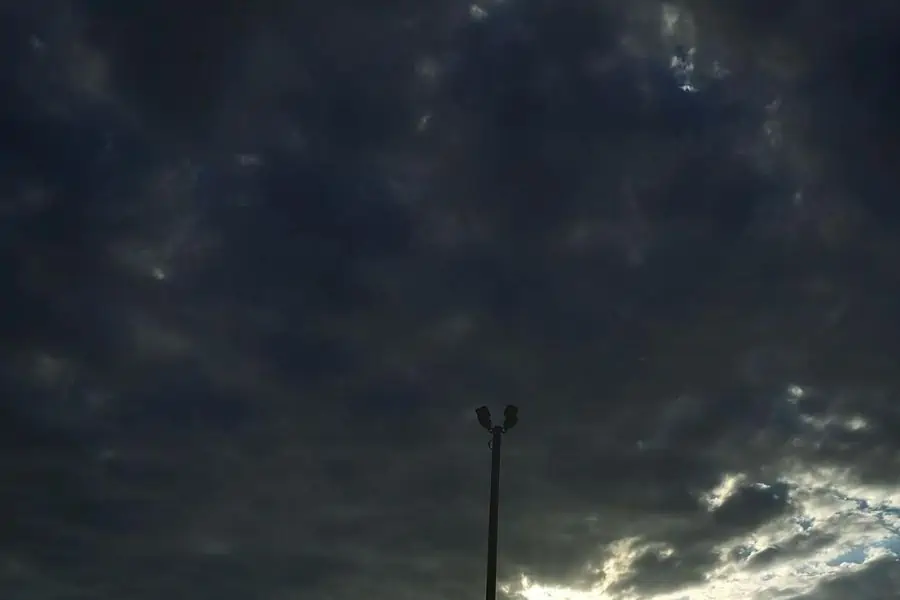
The white clouds get dark right before the storm starts.
That happens because the vapor inside them forms raindrops, causing clouds to become thicker and denser.
The thicker the clouds get, the less light they can reflect. For that reason, it appears darker in shade.
Abrupt Changes in Wind Direction

When the rain accumulates inside the clouds, the cool air is pushed down towards the Earth.
As it reaches the ground, it rushes outwards in the same direction storm is approaching, but faster.
That’s why you can feel a sudden change in the direction the wind is blowing when it’s about to rain.
Also See: How Much Wind Can A Tent Withstand?
Sudden Drop in Temperature
Another sign of a storm coming is a sudden drop in temperature. This happens because the cold air pushed towards the Earth is denser and heavier than warmer air.
As soon as you feel the temperature going down, rest assured it’s about to rain cats and dogs relatively soon.
Drop in Atmospheric Pressure
When the cool air is pushed towards the Earth, it forces the warm air upwards. This causes the air pressure to drop down.
If you’re unsure, check the barometer. If the mercury level is quickly dropping, reaching between 30.20 and 29.80 inches, then it’s clear it’s about to rain.
People who are sensitive to weather changes usually feel different when this happens, including having joint pain, headaches, and even migraines.
Of course, Thunder Sounds in the Distance
Not going to lie, I was today years old when I discovered what exactly makes the thunder sound after the lightning bolt.
You see, as the bolt hits the ground, there’s a second strike of lightning that returns from the ground to the clouds.
This returning strike creates immense heat when going back, heating up the air surrounding it to 48,632 F°.
This sudden increase in temperature causes a rapid increase in air pressure as well, up to 100 times the normal air pressure.
In such conditions, the heated air is pushed outwards, compressing the surrounding air. This results in a bursting noise, sent in all directions.
Staying Safe While Camping in a Thunderstorm
In case of an upcoming thunderstorm, there’s no need to panic. There are a few things you can do to stay safe during these weather conditions.
1. Choose the Right Campsite

How much and for how long it’s going to rain can’t always be predicted.
You should always keep in mind the possibility of a flood, and do your best to avoid finding yourself in the middle of it.
When you’re choosing the perfect spot to set up a campsite, make sure it’s not at the lowest point around.
That way, all water will simply run down and collect right where your tent is, creating a puddle.
Always look for slightly elevated ground, but don’t go all the way up.
You don’t want your tent to be the highest point in the area, as there’s a chance of lightning striking it.
Stay away from floating water and creek beds. In case of heavy rain, the volume of water can increase quickly, forming a rapid run-off.
This can cause flooding that can potentially tear away your tent.
Pay attention to rocks on slopes around you. As the ground soaks in the rainfall, it will turn into mud.
And as you know, the mud is slippery. The last thing you want is rocks to come down crashing on you.
Read: Camping in the Rain (Tips, Tricks, and Hacks to STAY Dry)
Have Alternatives for Shelter

In case of really bad weather, you might need an alternative shelter.
If you’re camping at a national or state park, there’s a good possibility of a storm shelter somewhere nearby.
Always research potential safety spots around you, so that you know where to find a shelter in case of emergency.
If there’s nothing in the approximate vicinity, a vehicle will work.
Use a Tarp for Extra Protection

A tarp can be of great help in case of a thunderstorm.
This affordable piece of camping gear is waterproof, so it can be used for additional protection against rain.
To assure no water gets inside your tent, you can place a tarp between the tent’s bottom and the ground.
One thing you need to make sure of is that the ends of the tarp don’t extend over the tent’s bottom.
If they do, they’ll provide the entryway for water to collect underneath the tent.
The other way you can use a tarp is to set it up above the tent for additional protection against the rain.
The raindrops will simply slide down the tarp and go towards the ground, away from your tent.
Read: 20+ Best Tarp Shelter Configurations for Easy Tarp Camping
Invest in an NOAA Weather Radio
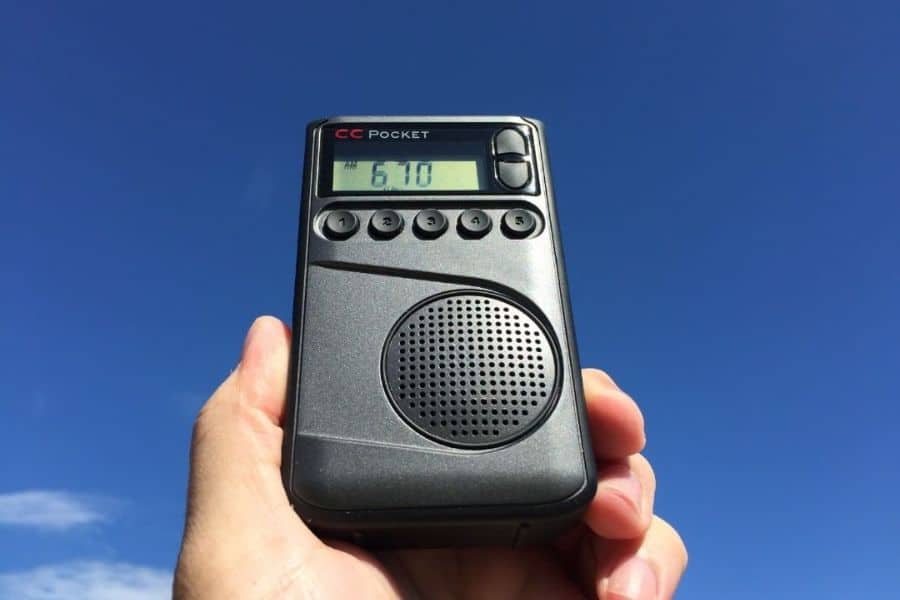
In case you don’t know, NOAA (which stands for National Oceanic and Atmospheric Administration) Weather Radio is a nationwide network of radio stations that broadcasts weather information from your nearest National Weather Service office. It works 24/7 and transmits regular forecast updates.
What’s great about NOAA radios is that they’re battery operated, and they work in remote areas that have no internet access of phone reception.
What’s more, it also sounds an alarm in case of severe weather situation in your area.
That includes different types of emergencies, including earthquakes, telephone outages and even oil spills.
Leave Your Tent During Severe Weather
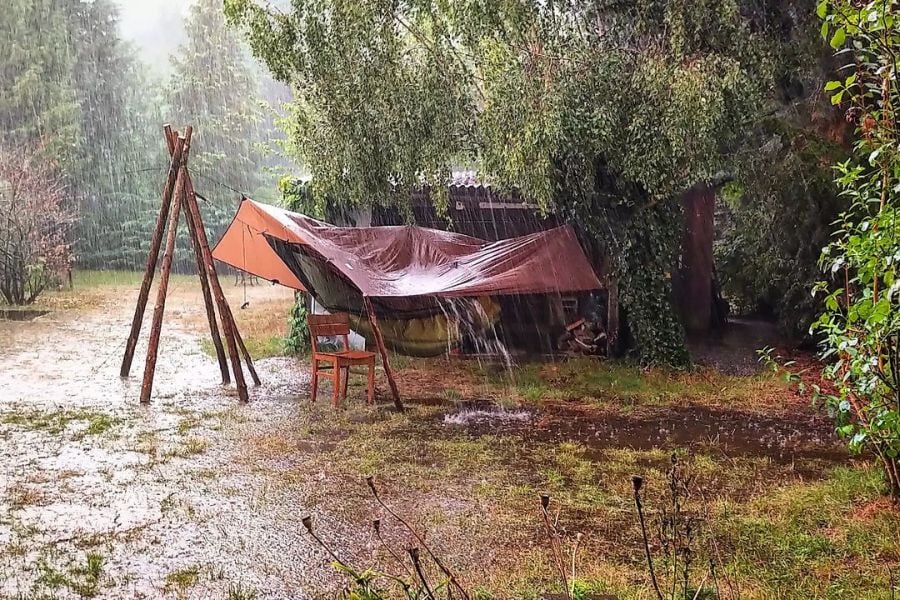
In case of severe weather conditions, it’s best to leave your tent altogether.
The majority of tents have poles made of metal, such as aluminum or steel. And as you probably know, metal is a great conductor.
Carbon fibre poles can also conduct electricity, although not as well as metal.
Now, I’m not saying that your tent will necessarily attract lightning. In case you’ve found a proper campsite, there should be other things that are at a higher elevation.
But there’s no 100% guarantee that the lightning will hit the highest thing around.
For that reason, it’s always best to stay away from a tent during a thunderstorm.
Don’t Stand in Water
I’m sure we’ve all seen a movie scene where someone throws a hairdryer into a tub filled with water, causing the person taking a bath to be executed.
One thing we can clearly conclude from such a scene is that water is a great conductor of electricity.
Interestingly enough, pure water is an isolator. But, there’s no pure water in nature.
The closest thing to “pure water” would be either distilled or deionized water, but even they still might contain ions.
Water in nature contains minerals and other compounds. Now, each of these compounds (especially salts) consist of anions and cations (charged ions).
In nature, there’s a balance between anions and cations, so that the water remains electrically neutral.
But if lightning was to hit the water surface, these ions will conduct electricity.
And if you’re standing in water at that time, there’s a pretty good chance you’ll be struck as well.
Insulate Yourself from the Ground

Even the ground itself can be a conductor of electricity. Especially when it’s soaked wet from all the rain.
And the thing is – it can conduct electricity from as far as 30 feet from the striking point.
For that reason, you want to have a layer of insulation between you and the bare ground.
When sitting, use a sleeping bat, a mattress or even a folded jacket. Just make sure you’re not touching the ground directly.
I say “sitting” because you should be touching the ground with only a small portion of your body.
If possible, it’s always best to stand. But if you get tired, try sitting or squatting.
Make sure you’re always wearing boots, as they also provide a layer of insulation from the ground.
Avoid Oaks, Look for Beech Trees
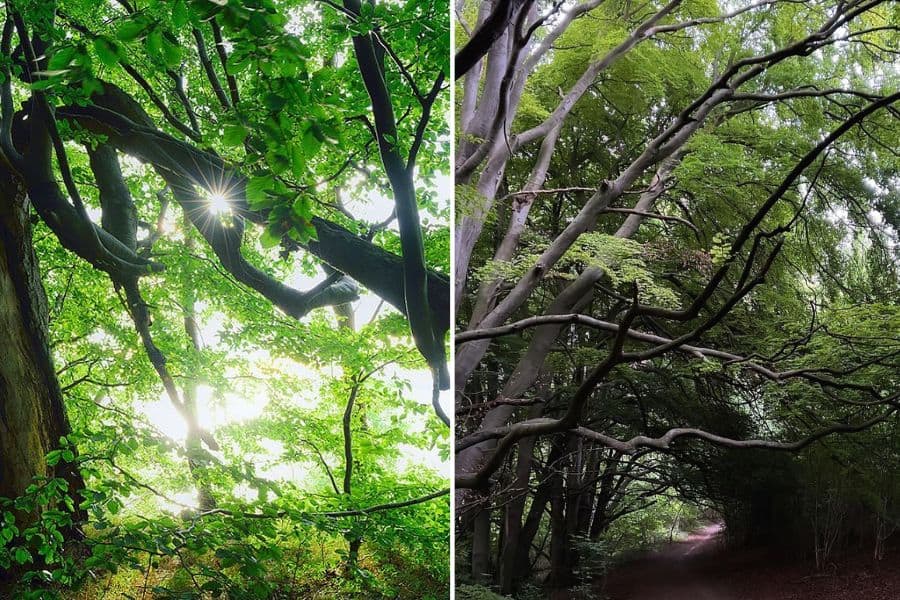
All trees attract lightning – that’s a fact. After all, they’re usually the highest thing it can hit.
But not all trees are equally risky to hide underneath.
I’ve heard people saying that you should hide underneath the oak tree as a cover.
Now, I don’t know where they got that from, but it’s a bunch of bs. The oak tree has a thick bark that can collect water.
And we all know that water will conduct electricity.
A beech, on the other hand, has a smooth bark, so the water simply runs down onto the soil.
And even if the lightning strikes the tree, it will simply carry the electricity directly into the ground.
Avoid High Ground

The lightning is more likely to strike something that’s at a higher elevation, such as on a mountain top or the hill.
For that reason, you don’t want to be too high up during a heavy storm.
If you see bad weather approaching, it’s best to get to lower ground until it passes.
A Safe Vehicle is the Best Option
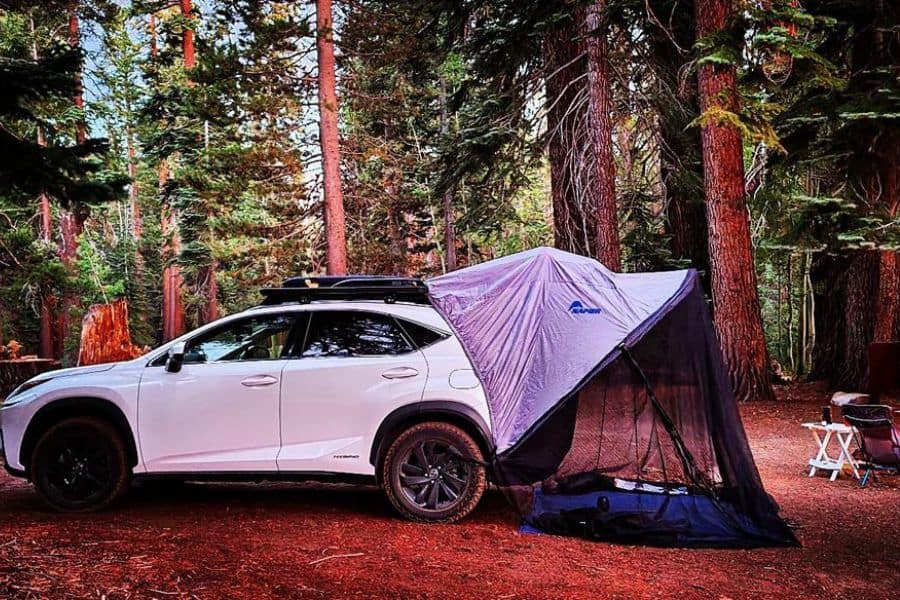
You might be wondering – how can a car be a safe shelter during thunderstorm if it’s made of metal?
Well you see, there’s something called the Faraday Cage Phenomenon.
Basically, in case of a lightning strike, the electricity would get distributed throughout the metal frame, on the external surface.
The interior of the car will remain protected, while the electricity would eventually go into the ground through the tires.
Of course, you don’t want to touch the doors or even the steering wheel, as these parts are connected to the car’s frame.
One thing to keep in mind – this only works with vehicles with a metal roof. With convertibles, there’s no enclosed metal frame to disperse electricity.
Places to Avoid During a Thunderstorm
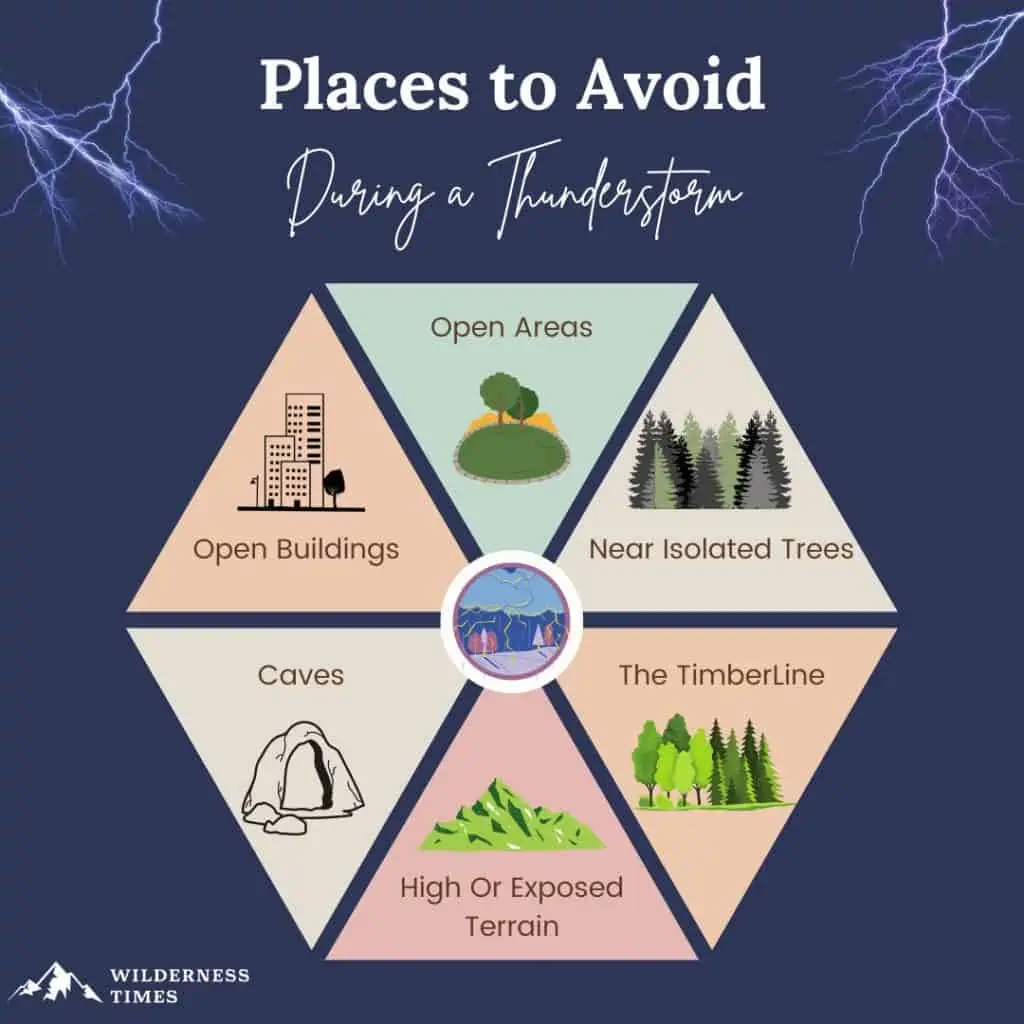
The storm is coming. There are certain places you don’t want to be when that happens.
Open Areas
Standing in a clear field is pretty much the same as standing at the top of the hill when it’s lightning. In both cases, you’re the closest thing to reach.
Near Isolated Trees
In most cases, trees will be the tallest object around. So naturally, they’re posing a great risk of a lightning strike.
This is especially true for isolated trees, as there’s nothing nearby to compete for being chosen as the lightning’s victim.
Open Buildings
Open spaces like barns or pavilions aren’t your friend when it comes to thunderstorms.
While a lightning might not strike them directly, they do pose a risk of getting side flashed.
Caves
If it’s shallow, a cave won’t be of much help against thunderstorms. You should only hide in those caves you can’t see the entrance from when you get inside.
The Timberline
You don’t want to find yourself above the timberline when you see the storm coming. Always lower yourself where trees form a closed canopy.
High Or Exposed Terrain
Be it a hill, cliff, cape or any other exposed part of the terrain, you don’t want to be there when it’s storm outside.
Understanding the Basics of Lightning Can Save Your Life
Most lightning-related accidents happen because of lack of knowledge on how they work.
Now, I don’t mean you should take an intermediate physics or meteorology class just to learn how they work.
In this section, we’ll cover everything you need to know about lightnings.
Side Flash Lightning
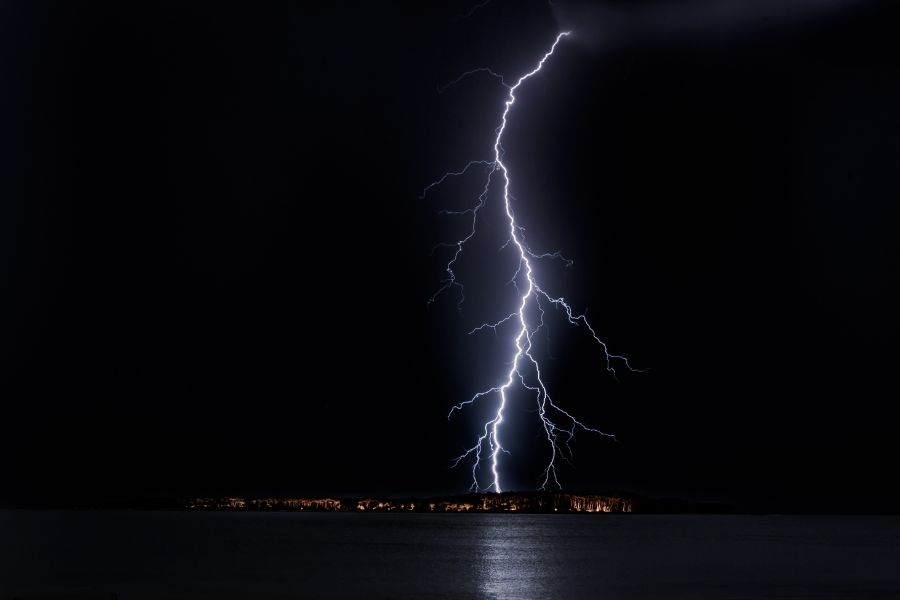
Lightning is usually directed towards the ground, but there’s a possibility of it straying from the original path and travelling towards another object in near proximity.
For instance, let’s say you pitched a tent with metal stakes underneath a tall tree.
If the lighting were to hit the tree, there’s a pretty good chance it would bounce off onto the metal stakes on the way to the ground.
Your body is also a potential destination for a side flash. For that reason, you want to stay away from things that can easily get struck.
Ground Current Lightning
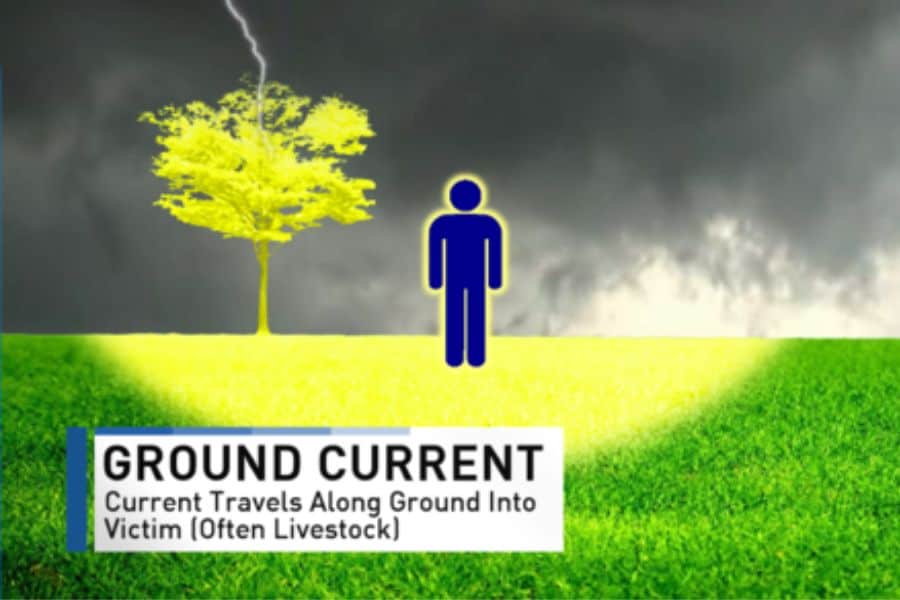
As we already established, the ground can be a good electricity conductor.
As the lightning strikes a tall object, it sends down the electricity towards the ground. From there, it’s dispersed in all directions.
The ground current can go as far as 100 feet from the place the lightning originally struck.
Most lightning-related injuries and deaths happen because of the ground current.
Many farm animals as well as wildlife have been killed from the energy dispersion after the lightning.
Streamer Lightning
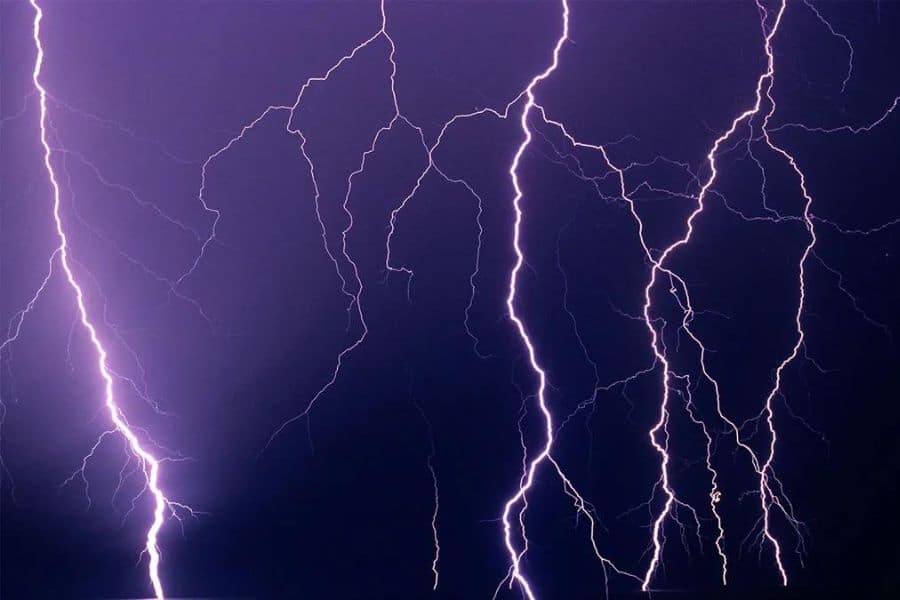
When lightning is about to strike an object, there’s also a possibility of the air between the lightning and the object can become positively charged.
Since lightning is negatively charged, the collision between the two can create the so-called upward streamer.
This type of lightning is potentially fatal if you find yourself positioned between the streamer and the lightning.
Conduction
While metal doesn’t exactly attract lightning, it does conduct it pretty well. Not just that, but it can also send the energy a long distance.
Wherever you are, be it outside or inside a shelter, make sure not to touch anything that can conduct lightning towards you.
This includes objects like pipes, fences, doors and even a wet rope.
Guessing a Thunderstorm’s Distance
Did you know there’s an easy but accurate way to estimate a thunderstorm distance?
We always see the lightning before we actually hear it. Well, the amount of time that passes in between can help you determine how far away it is.
Here’s what you need to do: when you see the lightning, count the seconds that pass by before you hear a thunder.
Do your best to count accurately. If you have a watch, that’s the best way to stay on point.
If you have to count in your head, it’s best to count in thousands. Like this – one one thousand, two one thousand, three one thousand…
Once you have your number, divide it by 5. That’s your distance in miles. If you want to use kilometers instead, divide it by 3.
Here are some examples
- 1 second between lightning and thunder: thunderstorm is about 300 meters/0.2 miles away
- 3 seconds between lightning and thunder: thunderstorm is about 1 kilometer/0.6 miles away
- 6 seconds between lightning and thunder: thunderstorm is about 2 kilometers/1.28 miles away
- 9 seconds between lightning and thunder: thunderstorm is about 3 kilometers/1.9 miles away
FAQ
How do you survive a thunderstorm in a tent?
If you absolutely must be inside a tent during a thunderstorm, make sure your body is not touching the poles or any other metal parts.
You should also add an additional layer of insulation between you and the ground. Finally, try squatting or sitting with as little body surface touching the ground.
Can you get struck by lightning in a camping tent?
If your tent is the highest object around, there’s a risk of getting struck by lightning. In case you’re using metal poles, the chance is even greater.
Do tents attract lightning?
Tents alone don’t actually attract lightning. But if they’re the highest object on an otherwise flat surface, then there’s a good possibility of that happening.
What to do when lightning strikes?
Find a shelter that will keep you safe from lightning. We’ve already covered what to avoid, and what can work as an emergency shelter in this situation.
To Sum Things Up
In case of an unexpected thunderstorm, don’t panic.
If you follow the safety instructions we discussed in the article, there’s no way why you can’t stay sheltered and dry during a thunderstorm.
If you play safe, camping in a thunderstorm can even be an enjoyable (or at least thrilling) experience.


